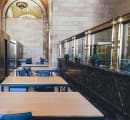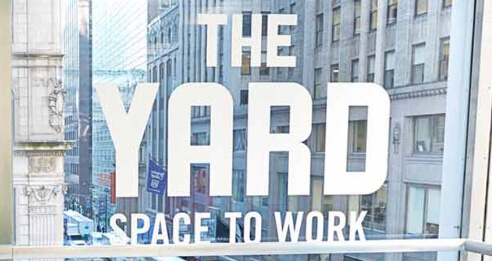
Largest Coworking Companies


Meeting rooms are not only a necessity for every coworking space but definitely a significant source of revenue. Setting them properly will boost their utilization and foster excellent member experience.
We’ve listed 6 things which will help you nail the process in the stages of planning and design.
There’s no universal set of meeting rooms, that’s suitable and profitable for all coworking spaces, because of the specifics of each space.
Exploring key attributes like the local business environment and the type of your target audience is key here.
It’s how you’ll understand what types of meeting rooms and how much of them would be the best fit for your coworking space.
If you’re in a business district or in the heart of a city that hosts a lot of business meetings, for example, it’s natural to expect plenty of drop-ins.
Most of them would need a small conference room where they can meet a client, or a phone booth to make a quick call between two flights.
Or you might be exposed to a lot of organizations and local communities, that often need a bigger space to host events.
Exploring the local business environment is key. Once you know what the major demand is, you can shape your meeting rooms to meet that demand, and also promote them properly so you can reach more of your target audience.
The type of the companies and professionals you aim to attract to your coworking space long-term would also point out how to plan your meeting rooms.
Are you targeting members whose work requires making tons of calls daily? The more phone booths you have, the better then. The last thing you’d like to have is a meeting room for 12 people being constantly booked for a call by a single person.
Technology companies, on the other hand, most often need plenty of space for internal meetings and brainstorming sessions. If the majority of your community consists of such companies, you’ll need to plan for bigger meeting rooms that can gather a whole team and offer opportunities for collaboration.
To figure out the best mix of meeting rooms for your coworking space, answering the following question would help:
Think about the specific needs of your members and the specifics of their business. This will give you valuable insights on what size, type, and style would best fit your audience.
Effective design is not only beautiful but functional in the first place. Setting up the right equipment is essential. Aim to offer a great experience for the people who’ll be using your meeting rooms.
Here are some essentials to consider when you start designing your meeting rooms:
Free space is commonly underestimated, but it strongly impacts member experience. When hosting a meeting room, your members shouldn’t feel as if the room is crowded.
When approaching fit-out, make sure there’s enough space between chairs and the wall behind them. Plan design in a way that allows people to move freely across the room even when it’s at its full capacity.
You should also consider the essence of the meetings that would be hosted there. While a formal meeting would require less space, a workshop or a brainstorm session would often require a spacious area, where people can walk, or interact with each other.
Beautiful furniture makes no sense if it’s not functional.
Regardless of how cool does that modern and stylish sofa might look like, if it’s not comfortable, it will become an issue.
The size and shape of the table should be considered so they don’t block the view towards the TV screen or between participants, once everybody sits on the table.
Knowing what atmosphere you’d like to create will impact your design and furniture choice as well - while colorful puffs and walls would be an awesome pick for informal brainstorming sessions, they would not be suitable if you want to create a formal feel for your meeting room.
Chosing names for your meeting rooms is another part of the design process, which will help you enhance a specific feel of your meeting rooms.
Although there are many details when setting up design and furniture in your coworking space, considering the well-being of the people who’ll be using your meeting rooms and knowing what types of meetings will be hosted, will help you make a better choice.
Countless studies have said it - the more natural light, the better.
Natural light comes with a lot of benefits like improving productivity, raising well-being and reducing electricity costs. It has also been said to be the number one office perk.
As it causes little eye strain, it’s suitable for conference rooms that will host long meetings.
Natural light has some cons of course. Direct sunlight on shiny surfaces or computer screens might cause unpleasant experience.
On the other hand, artificial light has benefits as well. Its intensity is adjustable and you have a variety of options for color temperature, which helps to create a specific atmosphere.
Warm colour temperature is used to promote comfort and relaxation, so it would be suitable for chill areas or informal meeting rooms.
On the other hand, cool lighting is said to keep you focused and alert for a long time. However, too much of it can turn these positive effects into negative and cause anxiety or stress, so you shouldn’t overuse it.
Have in mind that technology should be easily usable by both staff and members because if it’s not easy to use, it might cause a negative, rather than positive, effect. When applied properly, however, technology adds plenty of benefits to your meeting rooms and improve member experience.
Coworking management software, for example, will provide your members with a frictionless and fast process of booking a meeting room. In addition, it will give you access to utilization reports and other valuable data that will help you keep track of how your meeting rooms perform.
Access control is another technology you could rely on to provide top-notch experience in your meeting rooms. It’ll also offer lots of security benefits.
The technology amenities inside a meeting room should cover the basics - a TV, a full set of connection cables (like HDMI, mini display port cable, etc), and a projector in some cases depending on the type of meeting room.
The width of the TV screen should be approximately equal to the width of the table, so everyone around the table can see the screen.
Make sure that the distance from the screen to the farthest-away seat is not too big and allows even the smallest Excel chart to be viewed without difficulties from that seat.
Bonus tip:Placing signage with instructions on how to use the equipment (e.g. connecting your laptop to the TV or the projector, adjusting the picture, etc) would be of help to your members if they get stuck with the setup.
Once again, there are many details to consider. But putting efforts in understanding how the room will be used and what are the needs of your members will help you make the right choice about your conference rooms equipment.
There’s no universal meeting rooms recipe that’s applicable for every coworking space. One thing is sure, though - planning and designing consciously and with a purpose in mind is key.
Spend time and efforts to explore the demand and local environment. Get to know the needs of your customers. Consider their well-being. Think about how your meeting rooms will be used, and you’ll get plenty of valuable insights that will point out the right direction for you.
Save your community manager 41 hours each week—learn how The Yard did it with cloud-based access control.
Read the Case StudyThe Guide to Make Your Space More Profitable
Including interviews with experts and consultants.
Free access to our best guides, industry insights and more.
